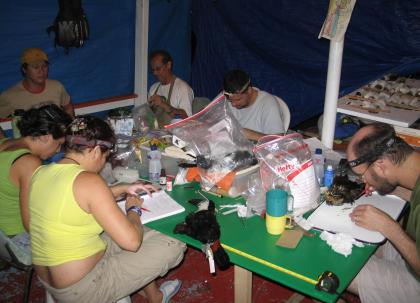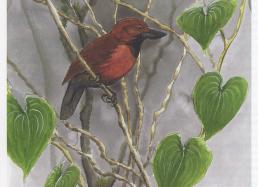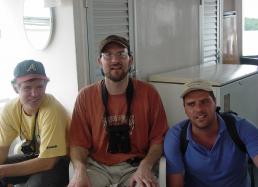Blog #8: Why We Collect
None of us like to kill birds, but that's what we must do to scientifically study and document the diversity of Amazonian species. This bothers many people, and we're regularly asked if there aren't other ways to study them.
In fact, there are other methods, but we believe that the collection of small numbers of individuals (5-10 individuals per species on this expedition) provides the breadth of data that is necessary if we're to understand their evolution and ecology (see above photo.) We strongly believe this is the best way to document the evolutionary history of each species, map its relationship to other species, and learn how populations have adapted to their environment through time.
We're confident that our work will result in a more thorough understanding of a species and its distribution, which leads to the preservation of both populations and habitats. There's also a measure of excitement associated with the work we do in that we're always hopeful of finding something completely new.
For example, in 1986 along the Rio Ji-Paraná, Dave Willard walked along a mist net line and found a captured bird that he immediately suspected could be an undescribed species (see Photo #1 below.) It was a rich brown antbird with a stout bill that had a distinctive upturned lower mandible. Dave and colleagues named the bird Rondonia Bushbird (Clytoctantes atrogularis), and even now it remains essentially unknown. It probably lives in dense vine tangles and could be confined to the region between the Rio Madeira and the Rio Tapajos. Until very recently, this specimen was the only documentation of its existence and habitat.
This kind of excitement extends to common birds as well, which we collect to assess population variation whenever possible. In other words, we sometimes collect specimens of species we've found in other locations to determine whether they represent different populations of the same species, or a distinct lineage that has long been evolving on a separate pathway. This has implications for conserving genetic diversity and habitat as well (see Photo #2 below.)
Biodiversity research centers typically provide scientific expertise on a variety of species. The Field Museum and the Goeldi Museum are two such centers for tropical birds, but the connections among the members of our group are deeper than that. Alex, Jason, and I are all graduates of the same doctoral program at the Museum of Natural Science of Louisiana State University (LSUMNS).
The research focus on tropical birds at the LSUMNS began under the direction George Lowery and has been continued by J.V. Remsen, Jr. and colleagues. Jason and Alex met at LSU and worked together in the field in Brazil during their doctoral work. I did my doctoral work in Bolivia before Jason and Alex arrived at LSU, but our experience there—working in the collections and labs and interacting with other graduate students with similar interests—helped shape us in ways that endure today (see Photo #3 below.)
Even before I got to LSU, I had experiences that convinced me that I wanted to build the capacity for science anywhere I worked, and getting a job at The Field Museum was the fulfillment of my dream. In my capacity as a curator and educator, I've had the opportunity to advise graduate students from Brazil, Peru, Venezuela, Argentina, South Africa, Uganda, and the Democratic Republic of Congo, who have studied at the University of Chicago and the University of Illinois, Chicago, and other regional and international institutions.
Few things give me more pleasure than seeing a student graduate and move on to a job. Historically, there weren't many jobs in South American countries, but with the economic boom in Brazil has come the strengthening of universities around this great country, and there are more jobs and more really excellent graduate students than ever before. Alex has brought two of his students on the trip. Maya Faccio is from São Paulo in the south and Elinete Rodrigues, is from Teresina, Piaui, in northeastern Brazil (see Photo #4 below.)
When I first started working in Brazil, it wasn’t easy to convince southern Brazilians to come to the Amazon to do research, but that has changed a lot. Today, graduate students at Brazilian universities have traveled throughout their great country, the scientific community is vibrant, and this is going to be an important factor for conservation in the long run.
With hope for the future,
John






